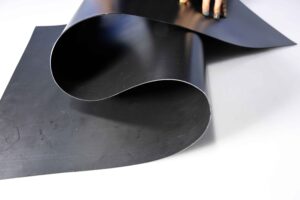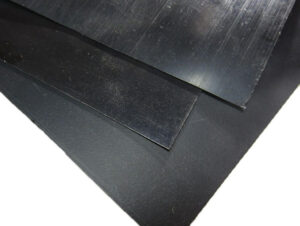What is the stiffness of geomembrane?
The stiffness of geomembranes is usually described by stiffness index or deflection. Stiffness index is a quantitative parameter of bending stiffness of a material under certain conditions, usually expressed in K value, and the unit is m⁴/N. Deflection refers to the degree to which a material bends when an external force is applied.
The stiffness of geomembranes can vary depending on the type and thickness of the material. In general, high-density polyethylene (HDPE) geomembranes have high stiffness, while linear low-density polyethylene (LLDPE) geomembranes have relatively low stiffness.
In addition, the stiffness of the geomembrane is also related to its thickness. Generally speaking, the stiffness of the thicker geomembrane will be higher.

What is the density of geomembrane?
The density of geomembrane usually refers to the density of the material, that is, the size of the mass contained in a unit volume. Geomembranes generally use polyethylene (PE) as the base material, and the density will vary depending on the type of polyethylene.
The density of HDPE geomembrane is generally between 0.94 g/cm³ and 0.97 g/cm³. The density of LLDPE geomembrane is usually between 0.92 g/cm³ and 0.94 g/cm³.

What is the thermal aging performance of geomembrane?
The thermal aging performance of geomembrane refers to the aging behavior of geomembrane materials under high temperature conditions due to changes in time and temperature. The thermal aging performance directly affects the service life and stability of the geomembrane.
Generally speaking, geomembrane should have good heat resistance and be able to keep its physical and mechanical properties stable within a certain temperature range. For geomembranes made of polyethylene (PE), indicators such as oxygen index, heat distortion temperature and heat aging test can usually be used to evaluate its heat aging performance.
The oxygen index is an index for evaluating the fire resistance of materials. The higher the value, the higher the oxygen concentration required for the material to burn, and the relatively better heat resistance.
Heat distortion temperature refers to the temperature at which the geomembrane material begins to soften and deform during heating. The higher the heat distortion temperature, the geomembrane is less likely to deform in a high temperature environment and has better heat resistance.
In addition, the thermal aging test can simulate the aging process of the geomembrane exposed to high temperature environment for a long time to evaluate the performance change of the geomembrane under thermal aging conditions.
Generally speaking, a high-quality geomembrane should have a high oxygen index, high heat distortion temperature, and good heat aging performance to ensure long-term stable use under high temperature conditions. When choosing a geomembrane, you can refer to relevant standards and specifications, and consult professionals for specific evaluation and selection.
Contact Us
[wpforms id=”40″]
Author
-

Founded in 2002, Tinhy's team focuses on the manufacturing, marketing, installation, application and research and development of geosynthetic materials.
View all posts




